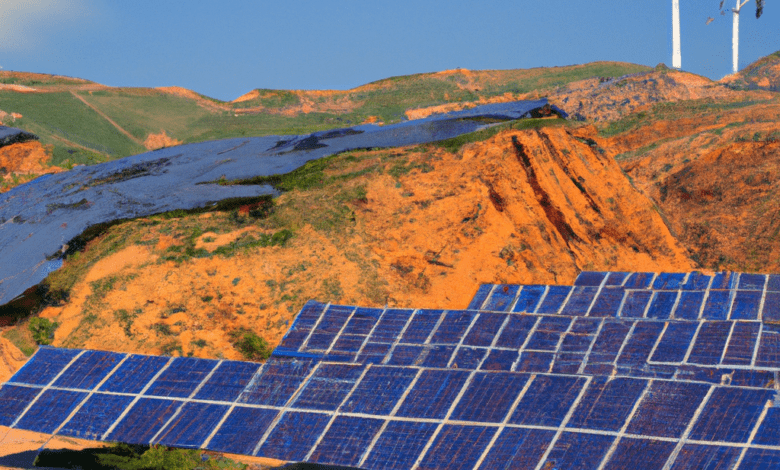Green Energy and Rare Earth Metals: Navigating the Demand Surge and Environmental Challenges

In an era defined by an urgent need for sustainable solutions, the rise of green energy technologies heralds a transformative shift in how we power our world. As nations strive to reduce their carbon footprints and transition to renewable energy sources, the demand for rare earth metals has surged, revealing a complex interplay between environmental aspirations and the realities of resource extraction. This article delves into the multifaceted impact of green energy technologies on the demand for these critical minerals, exploring how innovations in solar panels, wind turbines, and electric vehicles are shaping the landscape of rare earth mining. We will examine the driving forces behind this demand, the environmental implications of increased mining activities, and the indispensable role rare earth metals play in the development of sustainable technologies. As we navigate this balancing act, it becomes clear that the path toward a greener future is intricately linked to our stewardship of the planet's finite resources.
- 1. **"The Green Revolution: How Renewable Technologies Drive Demand for Rare Earth Metals"**
- 2. **"Balancing Act: The Environmental Implications of Rare Earth Mining in a Green Energy Era"**
- 3. **"From Wind Turbines to Electric Vehicles: The Critical Role of Rare Earth Metals in Sustainable Technologies"**
1. **"The Green Revolution: How Renewable Technologies Drive Demand for Rare Earth Metals"**
The transition towards renewable energy sources, often referred to as the Green Revolution, is reshaping various industries and driving significant changes in the global demand for resources. At the core of this transformation lies an increasing reliance on technologies that harness wind, solar, and other forms of green energy. While these innovations promise to mitigate climate change and reduce dependency on fossil fuels, they also create a burgeoning demand for rare earth metals, essential components in the production of many renewable energy technologies.
Rare earth metals, such as neodymium, dysprosium, and lithium, play a crucial role in the manufacturing of high-performance magnets, batteries, and catalysts that are integral to the functionality of wind turbines, electric vehicles (EVs), and solar panels. For instance, neodymium-iron-boron magnets are vital for wind turbine generators, enhancing their efficiency and power output. Similarly, lithium, commonly found in rechargeable batteries, is a key element in the shift towards electric mobility. As governments and industries globally push for the adoption of electric vehicles and renewable energy systems, the demand for these specific rare earths is expected to surge.
Moreover, the production of renewable energy technologies is not solely limited to the generation of power. The lifecycle of these technologies—from production to disposal—requires a consistent supply of rare earth metals, thereby establishing a feedback loop that further intensifies demand. As manufacturers strive to innovate and improve the efficiency of renewable energy systems, the need for advanced materials that include rare earth elements becomes increasingly pronounced.
However, this rising demand presents challenges. The extraction and processing of rare earth metals often involve environmentally harmful practices and significant geopolitical implications, as the majority of these resources are concentrated in a few countries. As the Green Revolution unfolds, it is crucial to consider not only the environmental benefits of renewable technologies but also the sustainability of sourcing the materials required for their development. This calls for a concerted effort to improve recycling technologies, develop alternative materials, and foster responsible mining practices to ensure that the momentum of the Green Revolution does not come at an unacceptable ecological or ethical cost.
In summary, the Green Revolution is driving a transformative shift in energy production that significantly increases the demand for rare earth metals. As the world moves towards a more sustainable future, understanding and addressing the implications of this demand will be essential for achieving a truly green energy landscape.
2. **"Balancing Act: The Environmental Implications of Rare Earth Mining in a Green Energy Era"**
As the world increasingly shifts towards green energy technologies, the demand for rare earth metals has surged, raising significant environmental concerns associated with their extraction. Rare earth elements (REEs) play a crucial role in the production of various green technologies, including wind turbines, solar panels, electric vehicle batteries, and energy-efficient lighting. However, the mining and processing of these metals often entail severe ecological consequences that challenge the very sustainability these technologies aim to promote.
The extraction of rare earth metals typically involves mining practices that can lead to habitat destruction, soil degradation, and water pollution. Open-pit mining, which is commonly used for REE extraction, disrupts large areas of land and can result in the loss of biodiversity. The chemicals used in the processing of rare earth ores, such as sulfuric acid, can contaminate local water supplies and harm aquatic ecosystems, leading to long-term environmental damage.
Moreover, the carbon footprint associated with rare earth mining and processing can be substantial. While green energy technologies are designed to reduce overall greenhouse gas emissions, the lifecycle emissions from the mining and refining stages can offset some of those benefits. For instance, the energy-intensive processes required to extract and purify rare earth metals often rely on fossil fuels, which contradicts the goals of carbon neutrality and environmental sustainability.
In response to these challenges, there is a growing emphasis on responsible sourcing and sustainable mining practices. Innovations in extraction technologies, such as bioremediation and closed-loop systems, aim to minimize waste and reduce environmental impacts. Additionally, recycling rare earth metals from electronic waste presents a promising solution that could alleviate the pressure on natural resources while decreasing the ecological footprint of REE supply chains.
Ultimately, achieving a balance between the increasing demand for green energy technologies and the environmental implications of rare earth mining requires a holistic approach. Policymakers, industry leaders, and researchers must collaborate to develop comprehensive strategies that prioritize sustainable practices, promote recycling, and invest in alternative materials. By addressing the environmental challenges associated with rare earth extraction, the green energy sector can move closer to its goal of fostering a truly sustainable future.
3. **"From Wind Turbines to Electric Vehicles: The Critical Role of Rare Earth Metals in Sustainable Technologies"**
The transition to sustainable energy technologies has brought renewed attention to the role of rare earth metals, which are essential components in the production of various green technologies. Wind turbines, electric vehicles (EVs), and solar panels heavily rely on these metals to enhance their efficiency and performance.
In wind turbines, rare earth elements like neodymium and dysprosium are crucial for manufacturing powerful permanent magnets used in direct-drive generators. These magnets enable turbines to operate more efficiently at lower wind speeds, making wind energy a more viable option across diverse geographical locations. As the demand for renewable energy sources grows, so does the need for these metals, leading to increased extraction and processing activities.
Similarly, the electric vehicle market has significantly escalated the demand for rare earth metals. EVs utilize rare earth elements in their motors and batteries, particularly in the production of high-performance magnets that improve the efficiency and range of electric drivetrains. Additionally, the development of advanced battery technologies often incorporates materials such as lithium and cobalt, along with rare earths, which are critical for optimizing energy storage and overall vehicle performance. As automakers pivot towards electrification in response to climate change, the pressure on rare earth supply chains intensifies.
The reliance on rare earth metals in these sustainable technologies raises important questions about the sustainability and ethical implications of their extraction. Most of the world's rare earth resources are concentrated in a few countries, leading to concerns over geopolitical stability, supply chain vulnerabilities, and environmental degradation associated with mining practices. Consequently, as the world accelerates its shift towards green energy, it must also consider the responsible sourcing and recycling of rare earth metals to ensure that the transition is truly sustainable.
In conclusion, the critical role of rare earth metals in sustainable technologies like wind turbines and electric vehicles underscores the complex interplay between advancing green energy initiatives and the environmental and social challenges associated with mineral extraction. Addressing these challenges will be essential for achieving a balanced and sustainable energy future.
In conclusion, the rise of green energy technologies marks a transformative shift in our approach to sustainability, yet it simultaneously escalates the demand for rare earth metals, which are essential for the manufacturing of renewable energy systems and electric vehicles. While the benefits of transitioning to renewable sources are undeniable, the environmental implications of extracting these critical minerals cannot be overlooked. As we navigate this complex landscape, it is imperative that we adopt a balanced approach—one that embraces innovation in green technologies while also prioritizing responsible sourcing and recycling of rare earth metals. By investing in sustainable mining practices and enhancing the circular economy, we can mitigate the ecological footprint of our pursuit for a greener future. Ultimately, the success of the green revolution hinges on our ability to harmonize the demand for essential resources with a commitment to environmental stewardship, ensuring that our path to sustainability is both effective and responsible.





